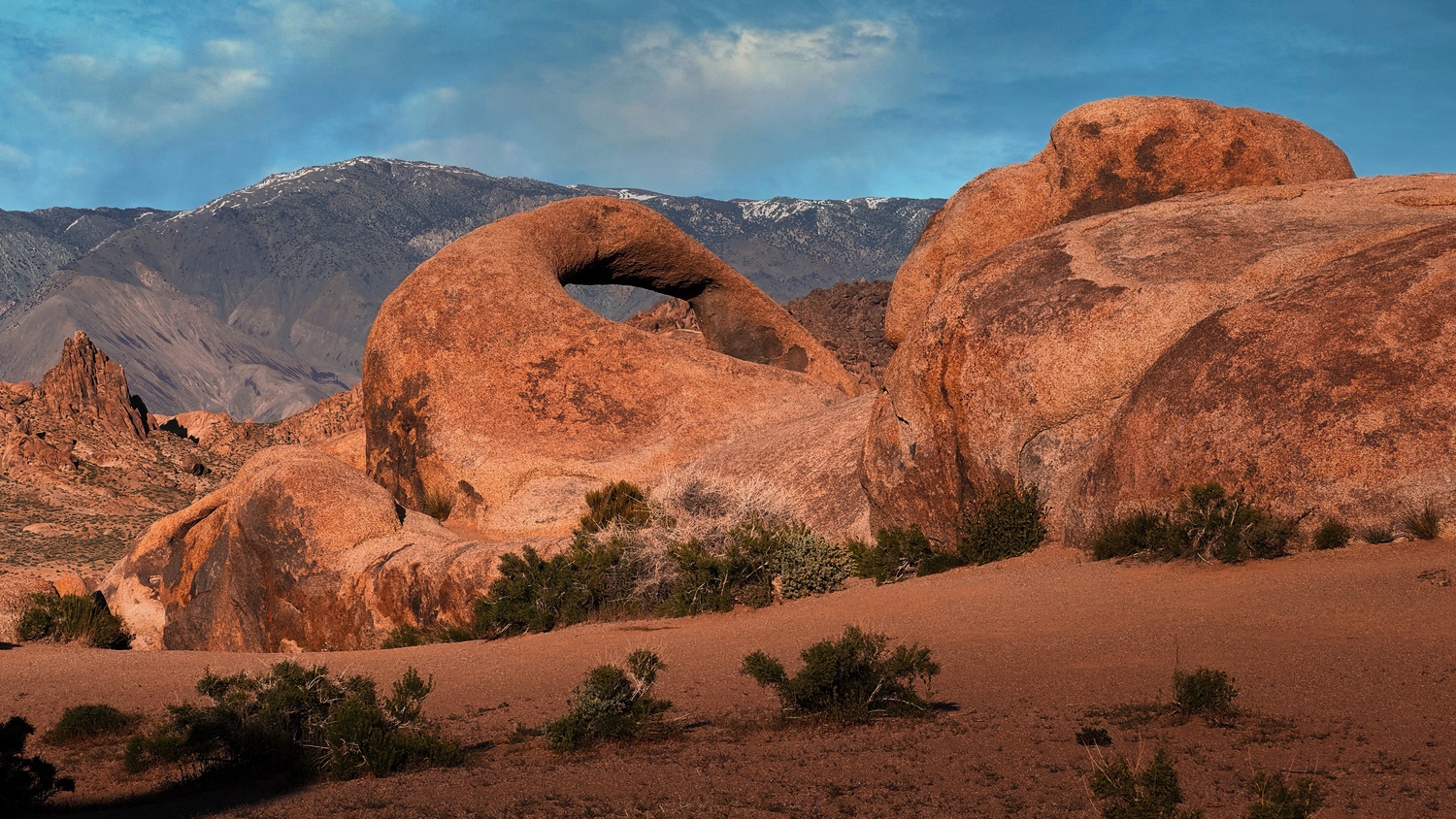In the 1920s, movie location scouts discovered the area, and because it was a reasonable driving time from Los Angeles, an endless parade of actors, directors, and equipment made the trek. The rounded rocks backed by the snowy Sierra Nevada Mountains were terrifically photogenic, even for black and white movies.
If you've seen the Lone Ranger TV series or Hopalong Cassidy, you've seen the Alabama Hills. "How the West Was Won" was partially shot there, so were Randolph Scott films like "The Tall T" and "Comanche Station." If you saw the movie "Tremors," you've seen a lot of the location, same for "Iron Man" and "Star Trek V." Lone Pine also could pass for India, and it did in "Gunga Din," or Afghanistan, as it did in the first "Iron Man" film. More than 400 movies have been shot here, and for good reason.
It's not a really well-known location to the general public, which is part of what makes it attractive. The Alabama Hills consist of around 30,000 acres of land that is BLM controlled. That means no passes or fees, camping is allowed, and even drones are free to fly.
There are always some visitors here, but it's easy to find your own people-free spot, and everywhere you point your camera it's a solid shot. That's what so impressed Hollywood and will likely impress you.
Getting to the Alabama Hills
Get your map app set on Lone Pine, California. It's on Highway 395, and while many tourists miss the nearby Alabama Hills, Lone Pine is between several major tourist destinations, such as Mount Whitney, Sequoia National Park, Kings Canyon National Park, Mammoth Mountain, Death Valley National Park, and Yosemite National Park. Lone Pine is a small town, with about 2,000 residents, but there are nice hotel rooms and some really good restaurants. The big event in Lone Pine is the yearly Lone Pine Film Festival that attracts actors who were in the movies shot there, crew, directors, and movie fans from all over the world. This year, it runs October 5-8. Don't expect to find a room while the festival is going on.
When You're There
Do stop by the Museum of Western Film History (701 S. Main Street). It's an interesting visit, with hundreds of artifacts and costumes from the movies shot there. The museum staff will also provide you with an Alabama Hills map, which will lead you to many of the specific locations where movies were shot.
You get to the Alabama Hills by turning west at the only traffic light in town. That's Whitney Portal Road, and it's also the way up to Mt. Whitney, the tallest mountain in the contiguous United States. But just a couple of miles after the turn is Movie Road, a road constructed for movie companies to get their heavy cameras and lights into the rugged scenery of the Alabama Hills. As soon as you turn on to Movie Road, you'll immediately recognize the terrain from the hundreds of movies shot there.
 Like most places out west, getting up before dawn and being there around sunset pay big dividends. I've also done some Milky Way photography there, and at certain times of year, there are plenty of colorful desert plants.
Like most places out west, getting up before dawn and being there around sunset pay big dividends. I've also done some Milky Way photography there, and at certain times of year, there are plenty of colorful desert plants.
The Alabama Hills are crisscrossed with roads, not many paved, and some will feel more comfortable with a four-wheel-drive vehicle. I've taken my sedan and a high-riding SUV with no problems there.
Since the area is drone friendly, you'll get some great shots from vantage points you can't easily hike to.
 There's also more than 400 natural arches at the Alabama Hills. Some can be seen from the road. Others are a hike.
There's also more than 400 natural arches at the Alabama Hills. Some can be seen from the road. Others are a hike.

Being close to Mt. Whitney offers some great shots. Here's a nine-image panorama I did with my drone last month from Whitney Portal Road on the way up into the mountains.

If you go to the Alabama Hills, take a 10-mile side trip North on Highway 395 to the Manzanar Relocation Center. It's where Japanese-Americans were held during World War II. It's a sad and humbling exhibit, very well presented by the National Park Service. At the entrance is a grim guard tower from that era, still standing.

As far as the weather goes, Lone Pine has generally low desert humidity, and I find spring and fall the best times to go. It can get cold, with January temps from the low 20s to the mid 50s. Much of the year, snow is visible in the Sierra Nevada Mountains.
So, Should You Go?
As you can tell from what I've shared, yes, you should. The scenery is some of the best in North America, but because it's not a National Park, it's not filled with people or rules. Visitors are respectful, and the Alabama Hills retain their breathtaking beauty. If you can go, go. You won't regret it. I think it's a landscape photographer's paradise. If you've been there, please share your thoughts below.







I should go. But it should definitely be off limits to everyone else.
As long as you take me with you then, yeah. I agree.
It was a magic wonderful place they discovered. So they went and invited their friends, and their friends came, and their friends came. Then one day there were so many rv’s that there was no where to park.